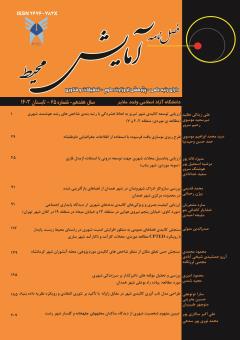ارزیابی پتانسیل محلات شهری جهت توسعه درونی با استفاده ازمدل فازی (نمونه موردی: شهر بناب)
محورهای موضوعی : آمایش محیطمنیژه لاله پور 1 * , مرضیه اسمعیل پور 2 , هوشنگ سرور 3
1 - دانشیار گروه جغرافیا و برنامه ریزی شهری دانشگاه مراغه
2 - استادیار گروه جغرافیا و برنامه ریزی شهری دانشگاه مراغه
3 - دانشیار گروه جغرافیا و برنامه ریزی شهری دانشگاه مراغه
کلید واژه:
چکیده مقاله :
در پی رشد سریع جمعیّت و ظهور تحولات جدید شهرنشینی در جهان، شاهد گسترش الگوهای توسعهی شهری همانند گسترش افقی و پراکندهرویی هستیم که باعث شکلگیری حومهها، تخریب اراضی کشاورزی و باغی و به فراموشی سپرده شدن بافتهای میانی و تهیشدن آنها از درون شده است. این امر لزوم به کارگیری ظرفیتها و پتانسیلهای درونی و میانی شهر را ضروری مینماید. از این رو هدف این پژوهش، شناسایی و بررسی ظرفیتها و پتانسیلهای توسعه درونی در شهر بناب میباشد. نوع تحقیق کاربردی و روش بررسی آن توصیفی - تحلیلی است و شیوه جمعآوری اطلاعات مبتنی بر مطالعات کتابخانهای (اسنادی) و میدانی میباشد. در این پژوهش، با 11 معیار تأثیرگذار شامل اراضی بایر، تراکم خالص جمعیّت، تراکم ناخالص جمعیّت، تراکم ساختمانی، سطح اشغال کاربریها، مصالح ساختمانی، کیفیت بنا، بافت فرسوده، اندازه قطعات و دانهبندی، تعداد طبقات و شیب جهت توسعه درونزای محلات شهر بناب مورد بررسی قرار گرفت. پس از تولید لایههای GIS مرتبط با شاخصها و معیارها و فازی سازی آنها، با همپوشانی لایهها بهترین محلهها از شهر جهت توسعه درونی انتخاب شدند. سپس با بهرهگیری از نظرات کارشناسان و با استفاده از فرآیند تحلیل سلسله مراتبی (AHP) این معیارها وزندهی شدند و در مرحله بعد با استفاده از نرمافزار ArcGIS نقشه توسعه درونی منطقه مورد مطالعه تولید و میزان قابلیت محلات جهت توسعه مشخص گردید. در پایان دو نقشه نهایی برای پتانسیل توسعه درونی به دست آمد و مقایسه شد. نتایج پژوهش نشان میدهد که محلات 11 و 13 در اولویت اول توسعه و محلات 4،5،6 در اولویت دوم توسعه قرار دارند. محلات 7،8،10 کمترین ظرفیت توسعه را دارند.
Following the rapid growth of the population and the emergence of new urbanization developments in the world, the present researchers are witnessing the indiscriminate expansion of cities and the increasing dispersion of cities, which has led to the destruction of agricultural lands and gardens, and to the forgetting of the middle tissues and their emptying from the inside. Iranian cities have not been exempted from this; A problem that makes it more necessary to use the inner and middle capacities and potentials of cities. Therefore, the purpose of this research is to identify and investigate the capacities and potentials of internal development in Bonab. The type of applied research and its investigation method is descriptive-analytical and the method of collecting information is based on library (document) and field studies. In this research, with 11 influential criteria, including barren land, net population density, gross population density, building density, occupancy level, building materials, building quality, worn texture, size of parts and grading, number of floors and slope for the endogenous development of Bonab neighborhoods was investigated. After producing the GIS layers related to indicators and criteria and their fuzziness, by overlapping the layers, the best neighborhoods of the city were selected for internal development. Then, by taking advantage of experts’ opinions and using the Analytical Hierarchy Process (AHP), these criteria were weighted, and in the next step, using ArcGIS software, the internal development map of the studied area was determined and the ability of the localities for development was determined. The research results show that neighborhoods 11 and 13 are in the first priority for development and neighborhoods 4, 5, and 6 are in the second priority for development. Neighborhoods 7, 8, 10 have the lowest development capacity.

